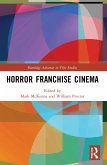Why can fear be pleasurable? Why do we sometimes enjoy an emotion we otherwise desperately wish to avoid? And why are the movies the predominant place for this paradoxical experience? These are the central questions of Julian Hanich's path-breaking book, in which he takes a detailed look at the various aesthetic strategies of fear as well as the viewer's frightened experience. By drawing on prototypical scenes from horror films and thrillers like Rosemary's Baby, The Silence of the Lambs, Seven and The Blair Witch Project, Hanich identifies five types of fear at the movies and thus provides a much more nuanced classification than previously at hand in film studies. His descriptions of how the five types of fear differ according to their bodily, temporal and social experience inside the auditorium entail a forceful plea for relying more strongly on phenomenology in the study of cinematic emotions. In so doing, this book opens up new ways of dealing with these emotions. Hanich's study does not stop at the level of fear in the movie theater, however, but puts the strong cinematic emotion against the backdrop of some of the most crucial developments of our modern world: disembodiment, acceleration and the loosening of social bonds. Hanich argues that the strong affective, temporal, and social experiences of frightening movies can be particularly pleasurable precisely because they help to counterbalance these ambivalent changes of modernity.
"In this compelling and wonderfully readable volume, Julian Hanich seeks to analyze the specific pleasures of cinematic fear by first canvassing the generic pleasures of cinema: the visceral thrill of adrenalized action sequences; the transgressive charge of forbidden fruit such as R-rated movies and identification with villainous characters; and the smug intellectual pleasures of film aficionados demonstrating their cultural capital through appreciation of intertextuality, genericity, and aesthetic strategies." --Jane Stadler, Projections









